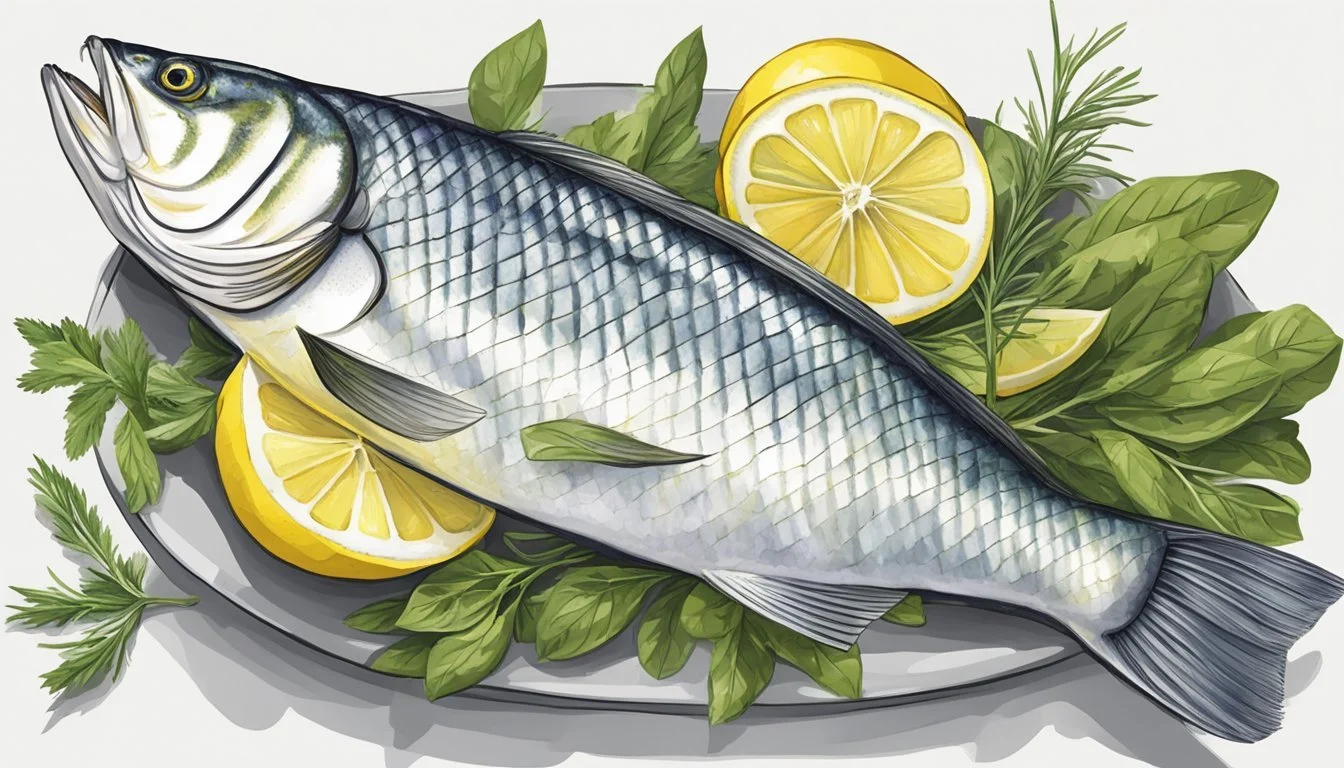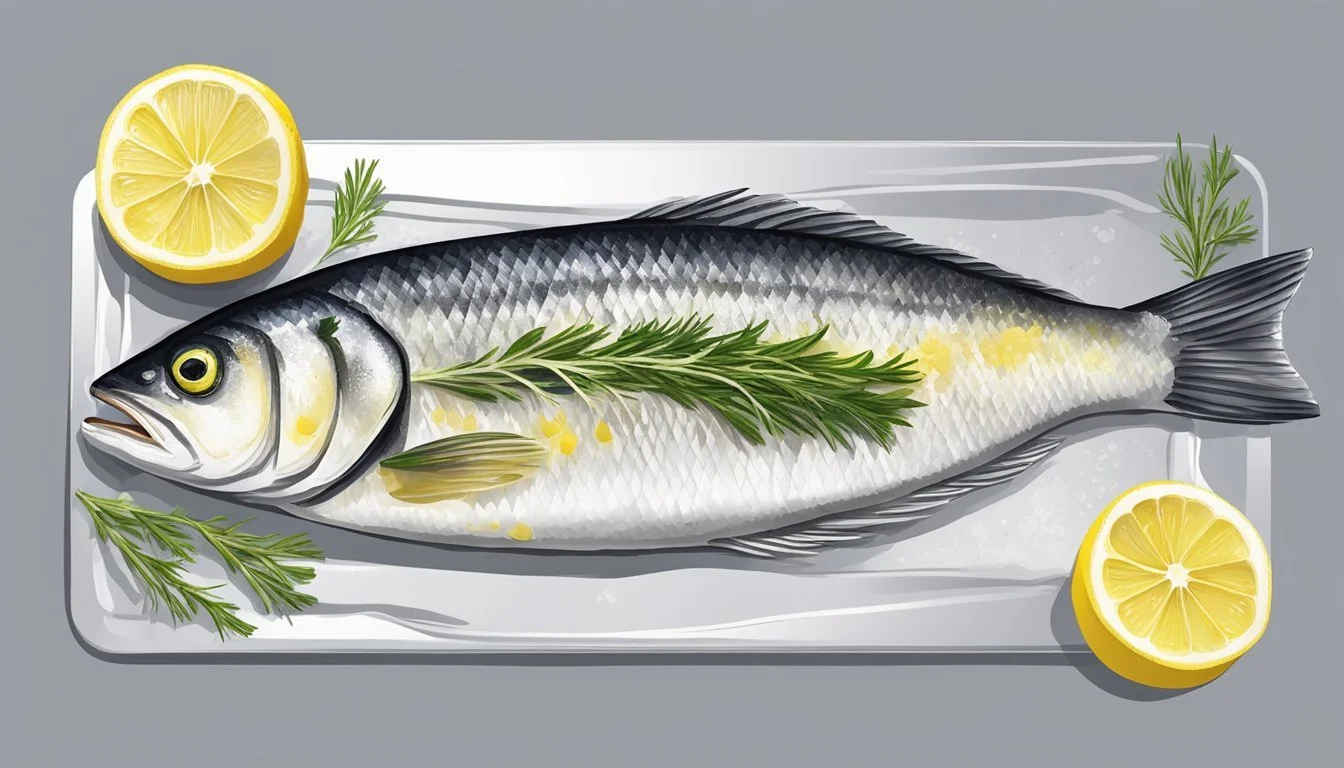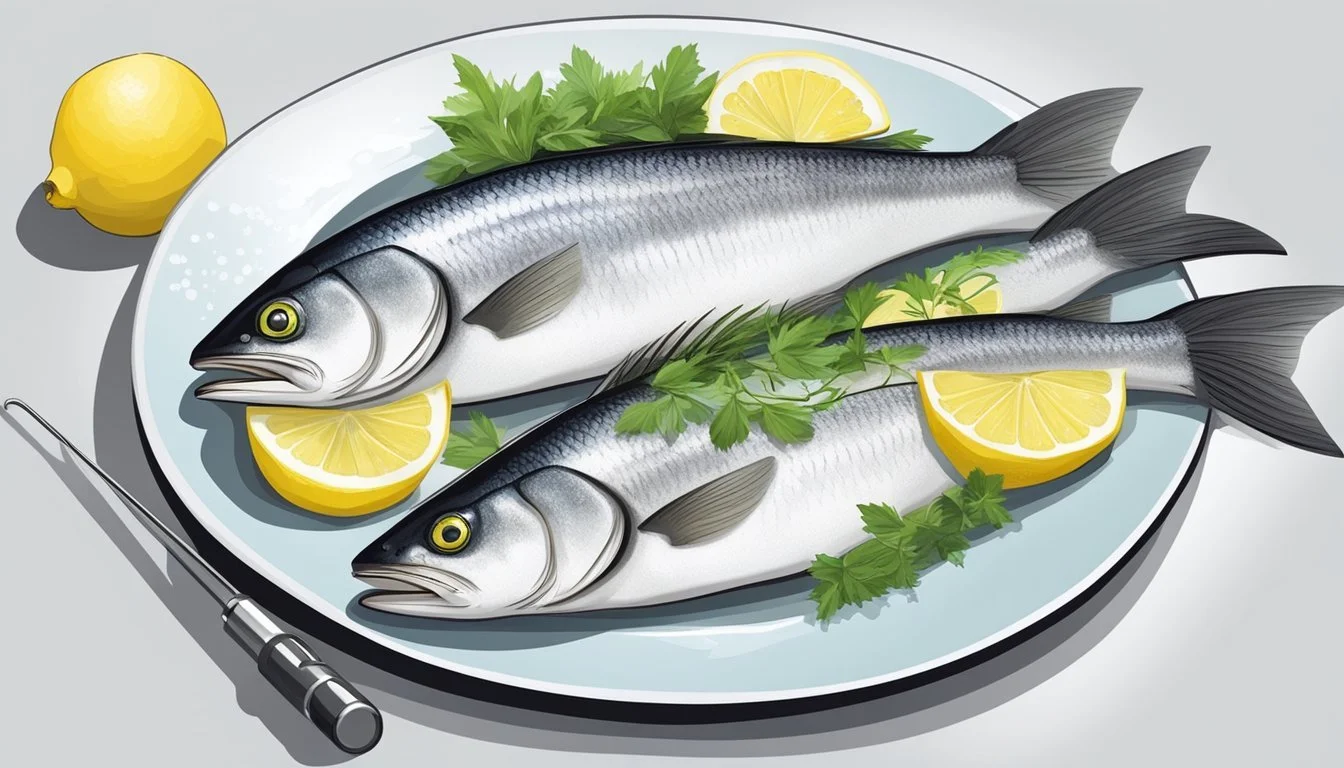Best Way to Reheat Branzino with Lemon and Herbs
Ensuring Perfect Flakiness Every Time
Branzino, a Mediterranean seabass, is known for its delicate, white flesh and is frequently prepared with lemon and herbs to enhance its natural flavors. The challenge often arises when it comes to reheating this fine fish without compromising its moist flakiness. Achieving this requires a methodical approach, taking into consideration the fish's (What wine goes well with fish?) texture and the need to preserve the subtlety of its herb-infused taste.
When reheated properly, branzino retains the qualities of a freshly cooked fillet: the exterior should be slightly crisp while the interior remains tender and flaky. To maintain these textures, as well as the integrity of the lemon and herb seasonings, the heating process should be gentle and controlled. Direct and excessive heat is to be avoided, as it can lead to dryness and can disperse the carefully balanced flavors established during the initial cooking.
Preserving the moisture of branzino is crucial to keeping the fish's flakiness intact. Whether one opts for an oven, stovetop, or even microwave reheating method, each has its own set of guidelines to ensure the fish emerges from the heat as delectable as it was when first served. The endeavor is not just to warm the fish through, but to revive it in a way that belies the fact that it has been cooked twice.
Understanding Branzino
Branzino, also known as European bass or loup de mer, is a white fish treasured for its delicate flavor and flaky texture. Notably different from rich, fatty fish like salmon, branzino possesses a mild, subtly sweet taste that appeals to a broad audience, especially in Mediterranean cuisine.
Physical Attributes:
Size: Typically reaches about 1 to 3 pounds.
Shape: Elongated body with a silvery-grey coloration.
Culinary Profile:
Texture: Lean with a tender, flaky consistency when cooked.
Flavor: Mild and sweet, making it versatile for various herbs and seasonings.
When purchasing branzino, one often finds it sold as a whole fish, sometimes already scaled and gutted for convenience. Its size makes it ideal for individual servings or sharing for two when presented as a centerpiece at the dining table.
Cooking Techniques:
Roasting: Branzino responds well to roasting, often with lemon and herbs to enhance its flavor.
Grilling: Grilled branzino gains a smoky character while maintaining moisture.
As a white fish, branzino is a healthier alternative to some other types of fish. It is rich in protein and contains essential omega-3 fatty acids, though in lower quantities than oily fish such as sea bass or salmon.
When compared to sea bass, branzino's texture is slightly less dense but equally enjoyable. For culinary enthusiasts, this fish presents an opportunity to explore a variety of recipes while enjoying a meal that is both refined and satisfying.
Preparation Essentials
The key to reheating branzino is to first ensure proper selection, storage, and seasoning before the initial cooking process. Understanding these steps is crucial for maintaining the fish's delicate flavor and texture when later reheated.
Selection and Storage
When choosing whole branzino, it is vital to select fresh fish for optimal taste and texture. Characteristics of freshness include:
Clear, bright eyes
A clean smell, reminiscent of the sea
Shiny and firm flesh
A trusted fishmonger is a valuable resource for obtaining high-quality, Mediterranean flavors. Post-purchase, proper storage is essential to maintain freshness. If not cooking the branzino immediately, one should:
Refrigerate it at temperatures just above freezing
Use it within 24 hours or
Freeze promptly, ideally in a vacuum-sealed bag
Ingredient Overview
The inherent flavor of branzino is best complemented with Mediterranean ingredients. Include:
Lemon: for its bright, acidic component
Fresh herbs: such as thyme and parsley, to infuse the fish with fragrant notes
Olive oil: to add richness and moisture
Salt and pepper: for basic seasoning
These components work synergistically, enhancing the fish's subtle taste without overpowering it.
Proper Seasoning Techniques
Effective seasoning techniques start with using the right types of seasonings and applying them correctly. Key points include:
Using kosher salt and freshly ground black pepper for a balanced flavor profile
Applying a generous squeeze of lemon juice to provide a zesty note
Incorporating fresh herbs like thyme and parsley, finely chopped for even distribution
Season both the inside cavity and outside of the branzino to ensure that every bite is savory. Olive oil can be brushed onto the fish before roasting to lock in moisture and flavor.
By adhering to these preparation essentials, the reheating process will enhance rather than diminish the branzino's delicate texture and Mediterranean zest.
Initial Cooking Methods
When it comes to preparing branzino, two popular methods stand out for their ability to enhance the fish's natural flavor and texture: grilling and oven roasting. These techniques, when executed correctly, can yield a flaky texture and an aromatic finish, especially when complemented with lemon and herbs.
Grilling for Optimal Flavor
Grilling imparts a distinct char and a smoky flavor to branzino, aligning perfectly with the aesthetic of Mediterranean cuisine. To achieve the best results:
Preheat the grill to a high temperature.
Prepare the branzino by seasoning it with salt, pepper, and a drizzle of olive oil. Stuff the cavity with lemon slices and fresh herbs like rosemary, thyme, or oregano to infuse the flavors while it cooks.
Grill the branzino over direct heat for 5-7 minutes on each side. This method achieves a crispy skin and helps maintain the flaky texture of the fish.
Oven Roasting Basics
Oven roasting is a more controlled method that equally enhances the delicate, flaky nature of roasted branzino. To roast branzino in the oven:
Preheat the oven to 400°F (204°C), positioning the rack in the middle for even cooking.
Season the branzino both inside and out with salt and pepper, and coat with olive oil. Place lemon slices inside the cavity alongside favorite herbs, such as rosemary or thyme, for a lemony, aromatic touch.
Roast the fish on a baking sheet in the preheated oven for approximately 25 minutes or until the fish is cooked through and flakes easily with a fork. This gentle cooking method locks in moisture and ensures the fish maintains its Mediterranean Sea bass identity with a flaky, tender texture.
Reheating Techniques
To maintain the flaky texture of Branzino with lemon and herbs, gentle reheating methods that preserve moisture are essential. Here are several approaches one might consider to retain that desired flakiness.
Microwave Method
Using a microwave should be done with caution as it can quickly overcook the fish. Place the Branzino on a microwave-safe plate, cover with a damp paper towel to keep in moisture, and use a low-power setting. Heat in 30-second intervals, checking for warmness and flakiness.
Oven Reheating
Preheat the oven to a low temperature, around 275°F (135°C) to prevent drying out. Place the fish on a baking sheet and loosely cover with foil to lock in moisture. Reheat for about 10 to 15 minutes, checking periodically for doneness without overcooking.
Stovetop Warming
One can reheat Branzino on the stovetop by placing the fish in a skillet on low heat. Add a small amount of water or white wine to the pan, cover it to create steam, and gently warm the Branzino to preserve its flaky texture. This typically takes about 5 to 8 minutes.
Alternative Methods
For a crispier exterior, a toaster oven set at a low temperature can perform well. Ensure the Branzino is wrapped in foil to maintain moisture. For those with an air fryer, a few minutes at a low setting can reheat the fish adequately, though caution is required to avoid drying it out.
Serve and Pair
Reheating Branzino with Lemon and Herbs should be approached with care to maintain its delicate flavor. Choosing the right accompaniments and garnishes is crucial to complement the fish without overwhelming its natural taste.
Accompanying Dishes
When serving reheated Branzino, adhering to the principles of the Mediterranean diet can enhance the dining experience. The meal should incorporate:
Vegetables: Roasted vegetables such as zucchini, bell peppers, and cherry tomatoes offer a colorful and nutritious side that pairs well with the fish.
Potatoes: A side of roasted or mashed potatoes seasoned with garlic and onion can act as a hearty yet subtle accompaniment.
Salads: Opt for a light, leafy green salad dressed with olive oil and lemon to mirror the citrus notes in the Branzino.
Garnishing with Lemon and Herbs
The key to garnishing Branzino lies in enhancing its flavor without overpowering it:
Lemon: Add fresh lemon slices or a drizzle of lemon butter on the reheated fish to intensify its zestfulness.
Herbs: Sprinkle finely chopped fresh dill or perhaps parsley over the Branzino for a fresh herbal note that complements the lemon.
Nutritional Profile
Branzino, also known as European bass, is a white fish renowned for its lean protein content and delicate flavor. A typical branzino filet serving, which amounts to about 3 ounces (85 grams), contains approximately:
Calories: 90-100
Protein: 20 grams
Fat: 1.5-2 grams
Saturated fat: Minimal
Unsaturated fat: Predominant type
Cholesterol: 50-60 mg
Sodium: Low
Carbohydrates: 0 grams
Fiber: 0 grams
Trans fat: 0 grams
When branzino is served with lemon and herbs, the nutritional profile is scarcely affected. Lemon and herbs such as rosemary, thyme, or parsley contribute minimal calories but can significantly enhance the flavor without the need for high-calorie sauces. The addition of lemon juice could provide a nominal amount of vitamin C and help in the absorption of iron from the fish.
The unsaturated fats present in branzino, mostly omega-3 fatty acids, are associated with various health benefits. They can contribute to heart health and cognitive function when included as part of a balanced diet. Meanwhile, as a fish low in mercury, branzino can be a safer choice for regular consumption compared to other types of seafood.
Given that branzino is an excellent source of protein and relatively low in fat, it makes a good choice for individuals mindful of their cholesterol and saturated fat intake. The overall nutritional profile of branzino with lemon and herbs supports a diet aimed at maintaining good health and supporting an active lifestyle.
Culinary Variations
Exploring different fish types and herb-citrus mixes can offer unique flavors and textures when reheating branzino to maintain its characteristic flakiness.
Substituting Different Fish
While the light and flaky texture of branzino is ideal for many seafood recipes, particularly those with a Mediterranean flair, other fish can also be used. Red snapper and striped bass are excellent alternatives, offering similar textures and the capability to pair well with robust flavors. For a milder taste, tilapia or flounder can be substituted, but one should be cautious with the cooking time to preserve moisture. Heavier and meatier fish like halibut, swordfish, and trout could also be considered, although the cooking times and temperatures may need adjusting owing to their denser flesh.
Herb and Citrus Combinations
The classic combination for a branzino recipe often includes dill, rosemary, oregano, or basil, paired beautifully with citrus elements such as fresh lemon juice, lemon butter sauce, or citrus oil. The brightness of citrus can be adjusted according to personal preference, whether it be the subtle tang of lemon or the sweeter note of orange. To maintain the fish's moisture, a slight drizzle of citrus oil or a dab of lemon butter sauce could be applied after reheating. Experimenting with different herb and citrus combinations can transform a simple reheated dish into a variety of flavors, encouraging a flavorful journey with every meal.
Final Thoughts
When reheating Branzino with lemon and herbs, culinary techniques play a crucial role in maintaining the dish's integrity. To preserve the delicate flakiness of the Branzino, one should opt for gentle reheating methods. The moist heat from steaming can effectively warm the fish without drying it out. A short stint under the broiler helps to keep the skin crispy, contributing to the overall texture and flavor retention.
In Mediterranean cuisine, the balance of flavors and the quality of ingredients are paramount. Care is to be taken to ensure that the reheating process does not compromise the dish’s zesty lemon notes and the aromatic quality of its herbs. Wrapping the fish in foil can trap moisture and aromatics, thus keeping the flavors intact and preventing the herbs from burning.
Reheating Tips:
For optimized flavor and texture, reheat only until warmed through.
Use foil or a covered dish to retain moisture.
Consider adding a splash of water or wine to maintain humidity.
The preservation of skin integrity is equally significant. The skin of the Branzino should remain crisp to contrast with the tenderness of the flesh. A brief broil, watching carefully to avoid overcooking, will rejuvenate the skin's desirable texture.
Achieving restaurant-quality results in reheating Branzino with lemon and herbs lies in patience and gentle handling. Only with the right techniques can one ensure that the dish stands out in the vast landscape of Mediterranean flavors. Remember, each step is significant for preserving the Branzino's celebrated qualities.







